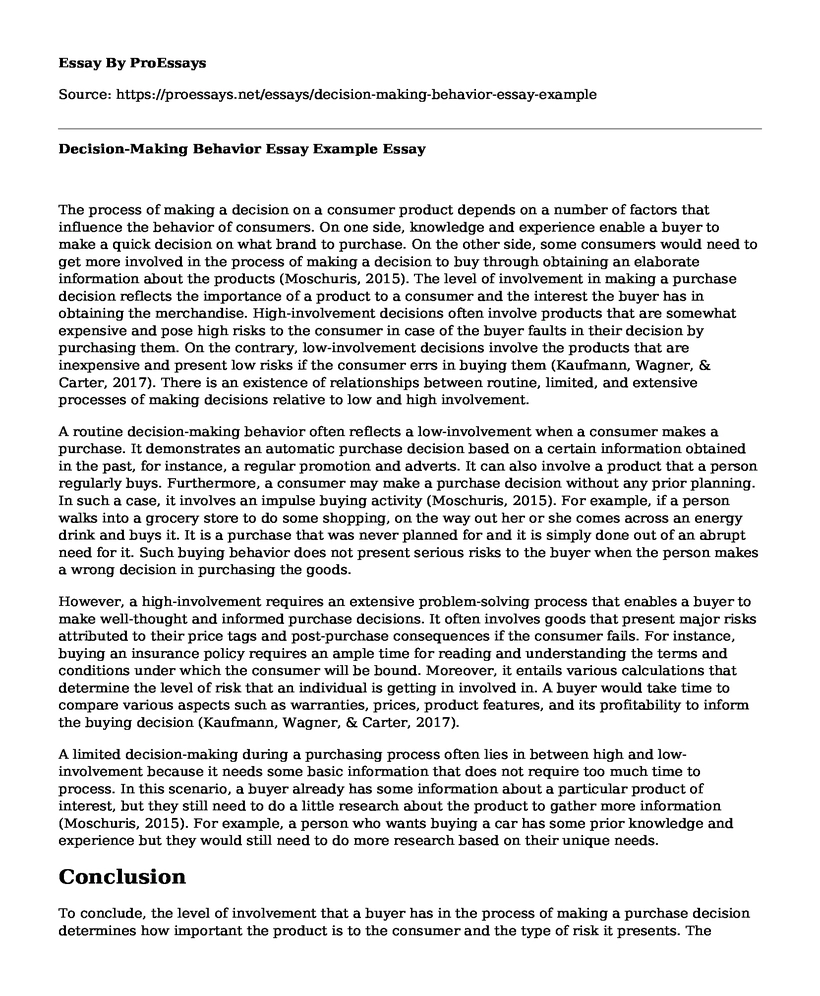The process of making a decision on a consumer product depends on a number of factors that influence the behavior of consumers. On one side, knowledge and experience enable a buyer to make a quick decision on what brand to purchase. On the other side, some consumers would need to get more involved in the process of making a decision to buy through obtaining an elaborate information about the products (Moschuris, 2015). The level of involvement in making a purchase decision reflects the importance of a product to a consumer and the interest the buyer has in obtaining the merchandise. High-involvement decisions often involve products that are somewhat expensive and pose high risks to the consumer in case of the buyer faults in their decision by purchasing them. On the contrary, low-involvement decisions involve the products that are inexpensive and present low risks if the consumer errs in buying them (Kaufmann, Wagner, & Carter, 2017). There is an existence of relationships between routine, limited, and extensive processes of making decisions relative to low and high involvement.
A routine decision-making behavior often reflects a low-involvement when a consumer makes a purchase. It demonstrates an automatic purchase decision based on a certain information obtained in the past, for instance, a regular promotion and adverts. It can also involve a product that a person regularly buys. Furthermore, a consumer may make a purchase decision without any prior planning. In such a case, it involves an impulse buying activity (Moschuris, 2015). For example, if a person walks into a grocery store to do some shopping, on the way out her or she comes across an energy drink and buys it. It is a purchase that was never planned for and it is simply done out of an abrupt need for it. Such buying behavior does not present serious risks to the buyer when the person makes a wrong decision in purchasing the goods.
However, a high-involvement requires an extensive problem-solving process that enables a buyer to make well-thought and informed purchase decisions. It often involves goods that present major risks attributed to their price tags and post-purchase consequences if the consumer fails. For instance, buying an insurance policy requires an ample time for reading and understanding the terms and conditions under which the consumer will be bound. Moreover, it entails various calculations that determine the level of risk that an individual is getting in involved in. A buyer would take time to compare various aspects such as warranties, prices, product features, and its profitability to inform the buying decision (Kaufmann, Wagner, & Carter, 2017).
A limited decision-making during a purchasing process often lies in between high and low-involvement because it needs some basic information that does not require too much time to process. In this scenario, a buyer already has some information about a particular product of interest, but they still need to do a little research about the product to gather more information (Moschuris, 2015). For example, a person who wants buying a car has some prior knowledge and experience but they would still need to do more research based on their unique needs.
Conclusion
To conclude, the level of involvement that a buyer has in the process of making a purchase decision determines how important the product is to the consumer and the type of risk it presents. The process also depends on the knowledge and experience that a person has. Therefore, a routine decision-making relates to low-involvement and extensive decision-making associates with high-involvement while limited decision-making lies in between the two.
References
Kaufmann, L., Wagner, C. M., & Carter, C. R. (2017). Individual modes and patterns of rational and intuitive decision-making by purchasing managers. Journal of Purchasing and Supply Management, 23(2), 82-93.
Moschuris, S. J. (2015). Decision-making criteria in tactical make-or-buy issues: an empirical analysis. EuroMed Journal of Business, 10(1), 2-20.
Cite this page
Decision-Making Behavior Essay Example. (2022, Jul 20). Retrieved from https://proessays.net/essays/decision-making-behavior-essay-example
If you are the original author of this essay and no longer wish to have it published on the ProEssays website, please click below to request its removal:
- Organizational Risk Management Paper Example
- Compare and Contrast Major Approaches to Managing and Improving Organizational Performance
- Marketing Research and Consumer Behavior Paper Example
- Bank Change Management Case Study
- Paper Example on Joy Inc.: Building a Successful Organization in a Competitive, Tech-Driven World
- Essay Example on Comparing Corporate Bonds to Government Bonds: Risks & Rewards
- Paper Example on Constructing Quality Structures: The Art & Science







